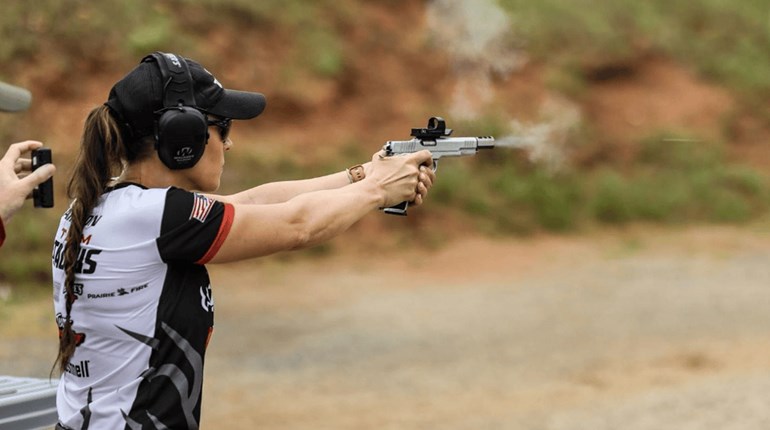
You may have gathered we’ve been on the road this week to take advantage of a rare opportunity—shooting with the some of the very best at USPSA’s first all-optics “Nationals.” Competition at this level is always an education, and quite often of the drinking-from-a-fire-hose variety. We made it through with a pistol caliber carbine without any egregious mishaps of our own making, and our gear had a lot to do with that. Few things are more distracting than “not-bang,” and we had none of that malarkey over two long days, 20 stages and an absolute minimum of 481 rounds.
Wishful thinking aside—or at least very selective recollection—such performance doesn’t come as easily as you might think. The rigors of the round count were supplemented by wind and talc-like sand here, and rain there (we were “lucky” enough to shoot parts of two stages semi-saturated). Our 100 percent functionality was, therefore, a welcome relief: Only one of our other trips to Nationals reached this plateau, meaning three others have not. We think just plain remarkable gear got us through.
JP Rifles
JP Performance—whether components or built-out firearms—doesn’t need much in the way of introduction. With military, law enforcement and competitive users now very common, the only explanation is capital-Q quality in just about every sense. More impressive, perhaps, is that our sample isn’t even the newest/latest/greatest according to JP. Our GMR-13 has now been superseded by the dual charging GMR-15 (or JP-15 conventional charging upper). The newer rifles add flared magwell, an improved magazine release, and last round hold-open on an empty magazine (which are ultra-reliable Glock, by the way, and of any small frame, staggered stack capacity).

Make no mistake, these features are a worthwhile advance, though our “old” rifle still put us third overall at the end of the first two days on a speed stage that compelled two reloads, though this didn't hold up long once the "big" talent showed up. So yes, we covet, but apparently did not really miss, the new configuration. Go ahead—get either newer version. We’ll grumble from afar.
Common to both rifles, however, is a “Supermatch” barrel, and our minor successes reinforced the value of the button-rifled, air-gauged, cryo-relieved JP tube. Conventional rifle accuracy buffs won’t be impressed with the 3” at 100 yards spec, but they need to reconsider: Pistol bullets just can’t stabilize like the longer, higher velocity, higher ballistic co-efficient projectiles that their rifle brethren employ. Still, our “old” JP's 152/160 stayed in the top 4% of points scored right to the end. Only our slow finger (no real excuse, given the superb JP EZ trigger) was to blame for the lower hit factor. On the ungenerous Classic target “A” zone, 28 of 32 shots went in for the top tally.
Given our optic, these were a relative piece of cake. Speaking of which …
C-More “Railway” Red Dot
If it’s any secret how much we like C-More reflex/red-dot sights, we’re definitely doing something wrong. We’ve put the STS through its paces on several handguns and long guns, and found it tops. Rugged and full-featured, it met all of our needs but one—a BIG(ger) dot.… this frequently translated into even better relative pairs at distance than up close.
We grant that dot size in a reflex sight is a comparatively major “boxers or briefs” sort of question: Rationale is sketchy except to you. Once you hit on what you like, you just know, though that may not render it perfect for a) others, or b) every other use. But we’d heard some shooters loudly extoll bigger dots, so with the help of Greg Danolds of C-More, we went all out: A 16 MOA (typical is 2 to 8) Railway CTRW.
We get it now, and—pardon the pun—big time. Proponents of smaller dots argue that big dots don’t have enough precision, and in one sense, they’re right: The subtension of a smaller dot is, well, smaller. But what those smaller dots may make more difficult is repeatable placement of the dot in relation to the borders of a target, and particularly of a distant one. With the accuracy of the JP/Supermatch barrel as aimed with the big dot C-More, every shot falls readily within the circumference of our dot, but the aiming cue itself is easier to position. The bigger dot, it seems, “wanders” less, and at least for us this frequently translated into even better relative pairs at distance than up close. The quality of the trigger press becomes the only remaining variable. We’re the first to admit we’re still learning, but so far? Impressed.
Best of all, with a Railway, you won’t be stuck with a size that doesn’t work for you. A paltry $49 gives you dot modules that plug in and swap your target cue to 2, 4, 6, 8, 12 or 16 MOA sizes. Try that with your … er, never mind.

One last but simple thing: There’s a propensity to think the Railway-type sight delicate because of the “proud” presentation of the lens above the sight body, but we’ve not found this to be true at all. Granted, no ball-peen hammers have been employed, but it is still a test. Attached to the JP with a built-in Picatinny/Weaver bracket, the C-More has now been airline manhandled, shipped, jostled, rained on, uncased/re-cased (hundreds of these), even dropped twice (damn it—that’s what we get for sharing!), and now shot a bunch in the most demanding venue we can easily concoct.
Some 500-plus match shots later (and several thousands in practice), the only possible knocks are on the operator.
Frank Winn has been studying arms and their relationship to tyranny, meaningful liberty and personal security all his adult life. He has also been a competitive shooter and firearms safety/shooting instructor for more than 20 years, though he won’t admit how many more than 20.

































